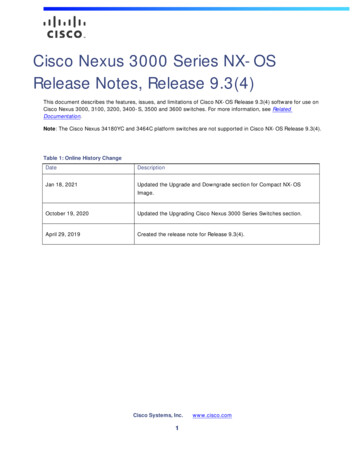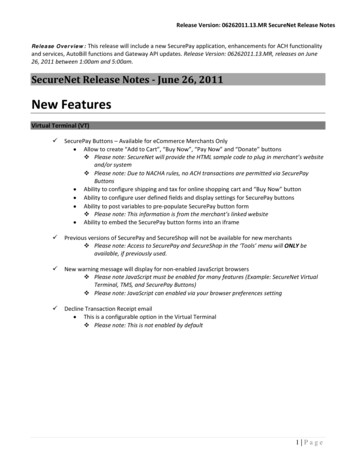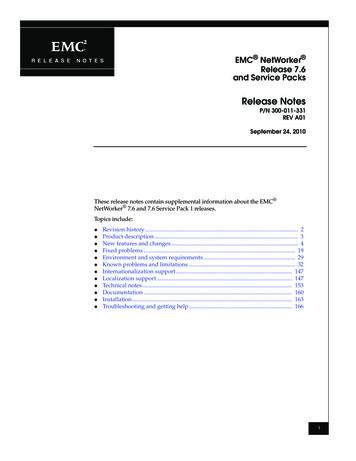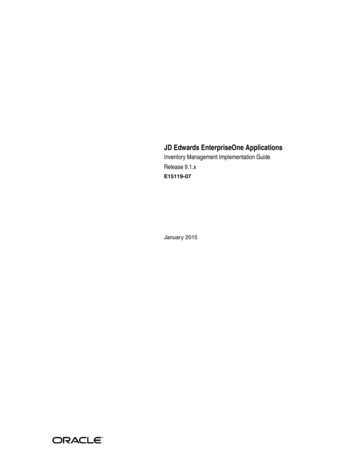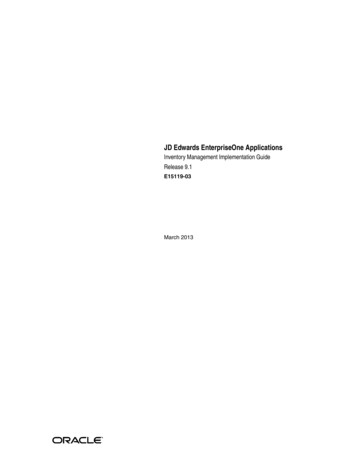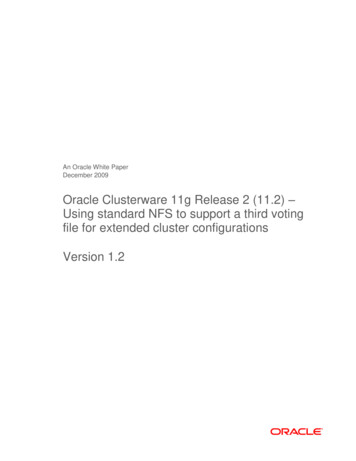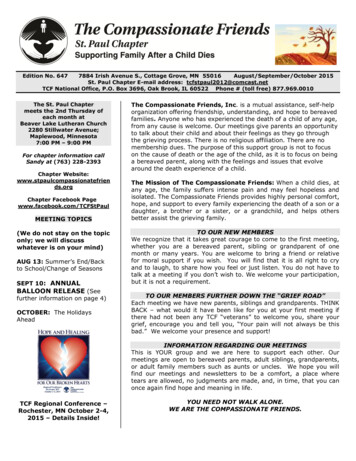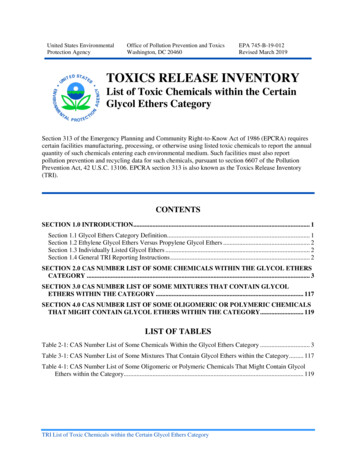
Transcription
United States EnvironmentalProtection AgencyOffice of Pollution Prevention and ToxicsWashington, DC 20460EPA 745-B-19-012Revised March 2019TOXICS RELEASE INVENTORYList of Toxic Chemicals within the CertainGlycol Ethers CategorySection 313 of the Emergency Planning and Community Right-to-Know Act of 1986 (EPCRA) requirescertain facilities manufacturing, processing, or otherwise using listed toxic chemicals to report the annualquantity of such chemicals entering each environmental medium. Such facilities must also reportpollution prevention and recycling data for such chemicals, pursuant to section 6607 of the PollutionPrevention Act, 42 U.S.C. 13106. EPCRA section 313 is also known as the Toxics Release Inventory(TRI).CONTENTSINTRODUCTION. 1Section 1.1 Glycol Ethers Category Definition. 1Section 1.2 Ethylene Glycol Ethers Versus Propylene Glycol Ethers . 2Section 1.3 Individually Listed Glycol Ethers . 2Section 1.4 General TRI Reporting Instructions . 2CAS NUMBER LIST OF SOME CHEMICALS WITHIN THE GLYCOL ETHERSCATEGORY . 3CAS NUMBER LIST OF SOME MIXTURES THAT CONTAIN GLYCOLETHERS WITHIN THE CATEGORY . 117CAS NUMBER LIST OF SOME OLIGOMERIC OR POLYMERIC CHEMICALSTHAT MIGHT CONTAIN GLYCOL ETHERS WITHIN THE CATEGORY . 119LIST OF TABLESTable 2-1: CAS Number List of Some Chemicals Within the Glycol Ethers Category . 3Table 3-1: CAS Number List of Some Mixtures That Contain Glycol Ethers within the Category. 117Table 4-1: CAS Number List of Some Oligomeric or Polymeric Chemicals That Might Contain GlycolEthers within the Category. 119TRI List of Toxic Chemicals within the Certain Glycol Ethers Category
DISCLAIMERThis guidance document is intended to assist industry with EPCRA section 313 reporting for the certainglycol ethers category. In addition to providing an overview of aspects of the statutory and regulatoryrequirements of the EPCRA section 313 program, this document also provides recommendations to assistindustry with EPCRA reporting. These recommendations do not supersede any statutory or regulatoryrequirements, are subject to change, and are not independently binding on either EPA or coveredfacilities. Additionally, if a conflict exists between guidance on this site and the statutory or regulatoryrequirements, the conflict must be resolved in favor of the statute or regulation.Although EPA encourages industry to consider these recommendations, in reviewing this document,industry should be aware that these recommendations were developed to address common circumstancesat typical facilities. The circumstances at a specific facility may significantly differ from thosecontemplated in the development of this document. Thus, individual facilities may find that therecommendations provided in this document are inapplicable to their processes or circumstances, and thatalternative approaches or information are more accurate and/or more appropriate for meeting the statutoryand regulatory requirements of EPCRA section 313. To that end, industry should use facility specificinformation and process knowledge, where available, to meet the requirements of EPCRA section 313.EPCRA section 313 also provides that, in the absence of such readily available data, a reporting facilitymay make reasonable estimates to meet those EPCRA section 313 requirements. Facilities are encouragedto contact the Agency with any additional or clarifying questions about the recommendations in thisdocument, or if the facility believes that EPA has incorrectly characterized a particular process orrecommendation.Additional guidance documents, including industry specific and chemical specific guidance documents,are also available on TRI’s GuideME website:https://ofmpub.epa.gov/apex/guideme ext/f?p guideme:gd-listTRI List of Toxic Chemicals Within the Certain Glycol Ethers Categoryii
INTRODUCTIONOn June 28, 1994, EPA promulgated a final rule (published in the Federal Register July 5, 1994, 59 FR34386) modifying the definition of the glycol ethers category on the list of toxic chemicals under section313 of the Emergency Planning and Community Right-to-Know Act of 1986 (EPCRA), 42 U.S.C. 11001et seq. The effect of this modification is that many high molecular weight glycol ethers were excludedfrom the category. As described in the final rule, this modification was made retroactive for the 1993reporting year for reports due July 1, 1994. This modification was also effective for all subsequentreporting years. As part of this modification and as the result of public comment, EPA changed thecategory name at 40 CFR 372.65(c) from ‘glycol ethers’ to ‘certain glycol ethers.’ However, thisdocument will refer to the constituents of this category simply as glycol ethers. At the time of themodification, EPA indicated that the Agency would work with the public and the regulated community todevelop, as appropriate, interpretations and guidance that the Agency determines are necessary tofacilitate accurate reporting for the modified glycol ethers category. This document constitutes suchguidance.Section 1.1 Glycol Ethers Category DefinitionThe glycol ethers category is defined by the following formula:R - (OCH2CH2)n - OR'where:nRR' 1, 2, or 3;Alkyl C7 or less, or phenyl or alkyl substituted phenyl;H or alkyl C7 or less, orOR' consisting of a carboxylic acid ester, sulfate, phosphate, nitrate, or sulfate.Chemicals that meet this category definition are reportable.EPA is providing three lists of CAS numbers and chemical names to aid the regulated community indetermining whether they need to report for the glycol ethers category. SECTION 2.0 lists individualchemicals that meet the definition of the EPCRA section 313 ‘certain glycol ethers’ category. This listconsists only of chemicals that have been assigned CAS numbers and, thus, is not exhaustive. If a facilitymanufactures, processes, or otherwise uses, in greater than threshold quantities, a glycol ether that meetsthe category definition, whether or not that chemical is on this list, they must report the chemical.SECTION 3.0 lists chemical mixtures which contain glycol ethers that meet the definition of the EPCRAsection 313 ‘certain glycol ethers’ category. EPA has tried to make this list as complete as possible;however, not all mixtures that contain reportable glycol ethers will necessarily appear on this list. If afacility manufactures, processes, or otherwise uses a mixture which includes components, in greater thanthreshold quantities, that meet the definition of the EPCRA section 313 ‘certain glycol ethers’ category,they must report the glycol ether component(s) that meet the category definition.SECTION 4.0 lists oligomeric and polymeric chemicals (for the category formula, R-(OCH2CH2)n -OR’,n is unspecified) that might contain a glycol ether component (n 1, 2, or 3). EPA has tried to make thislist as complete as possible; however, not all oligomeric or polymeric chemicals that might contain glycolethers will necessarily appear on this list. If a facility manufactures, processes, or otherwise uses anoligomeric or polymeric chemical that contains components, in greater than threshold quantities, thatmeet the definition of the EPCRA section 313 ‘certain glycol ethers’ category, they must report the glycolether component(s) that meet the category definition.TRI List of Toxic Chemicals Within the Certain Glycol Ethers Category1
Section 1.2 Ethylene Glycol Ethers Versus Propylene Glycol EthersThe members of this category are glycol ethers derived from ethylene glycol, diethylene glycol, andtriethylene glycol. This category does not contain glycol ethers based on propylene glycol, dipropyleneglycol, or tripropylene glycol.Section 1.3 Individually Listed Glycol EthersThere are two chemicals, 2-methoxyethanol (CAS number 109-86-4) and 2-ethoxyethanol (CAS number110-80-5) that are on the individual chemical list and CAS number list (40 CFR 372.65(a) and (b)).Threshold determinations should be made for each of these chemicals individually and separately fromthe glycol ethers category.Section 1.4 General TRI Reporting InstructionsFor general instruction regarding compliance with EPCRA section 313 requirements and formcompletion, please see the most recent version of the Toxic Chemical Release Inventory Reporting Formsand Instructions, available at: https://ofmpub.epa.gov/apex/guideme ext/f?p guideme:rfi-homeTRI List of Toxic Chemicals Within the Certain Glycol Ethers Category2
CAS NUMBER LIST OF SOME CHEMICALS WITHIN THEGLYCOL ETHERS CATEGORYEPA is providing the following list of CAS numbers and chemical names to aid the regulated communityin determining whether they need to report for the glycol ethers category. The following list consists ofindividual chemicals that meet the definition of the EPCRA section 313 ‘certain glycol ethers’ category.This list consists only of those chemicals that have been assigned CAS numbers and, thus, is notexhaustive. If a facility manufactures, processes, or otherwise uses, in greater than threshold quantities, aglycol ether that meets the category definition, whether or not that chemical is on this list, they mustreport the chemical.Table 2-1: CAS Number List of Some Chemicals Within the Glycol Ethers CategoryCollective Index NameOther NamesCAS NumberAcetic acid, chloro-, 2-phenoxyethyl ester2-Phenoxyethyl chloroacetate103-57-1Propanoic acid, 2-methyl-, 2-phenoxyethyl esterEthanol, 2-phenoxy-, isobutyrate;Isobutyric acid, 2-phenoxyethyl ester;Phenoxyethyl isobutyrate103-60-62-Propenoic acid, 3-(4-methoxyphenyl)-, 2-ethoxyethyl esterCinnamic acid, p-methoxy-,2-ethoxyethyl ester; Ethanol, 2-ethoxy-,p-methoxycinnamate; 2-Ethoxyethyl4-methoxycinnamate; 2-Ethoxyethylp-methoxycinnamate; Cinoxate; GivTan F; Give-Tan; p-Methoxycinnamicacid 2-ethoxyethyl ester; Phiasol;Sundare104-28-9Ethanol, 2-(2-phenoxyethoxy)-Diethylene glycol monophenyl ether;Phenoxydiglycol; Phenyl carbitol104-68-7Hexanedioic acid, bis(2-methoxyethyl) esterAdipic acid, bis(2-methoxyethyl) ester;Ethanol, 2-methoxy-, adipate (2:1);Bis(2-methoxyethyl) adipate;Di(2-methoxyethyl) adipate106-00-3Dodecanoic acid, 2-ethoxyethyl esterEthanol, 2-ethoxy-, laurate; Lauric acid,2-ethoxyethyl ester; 2-Ethoxyethyldodecanoate106-13-82-Propenoic acid, 2-ethoxyethyl esterAcrylic acid, 2-ethoxyethyl ester;Ethanol, 2-ethoxy-, acrylate;2-Ethoxyethyl acrylate; Cellosolveacrylate; Ethylene glycol monoethylether acrylate; Ethylene glycolmonoethyl ether propenoate106-74-1Dodecanoic acid, 2-butoxyethyl esterEthanol, 2-butoxy-, laurate; Lauric acid,2-butoxyethyl ester; Ethylene glycolmonobutyl ether laurate; Hallco C 311109-37-5Octadecanoic acid, 2-butoxyethyl esterEthanol, 2-butoxy-, stearate; Stearicacid, 2-butoxyethyl ester; 2-Butoxyethylstearate; Butoxyglycol stearate; Butylcellosolve stearate; Kesscoflex BCS109-38-69-Octadecenoic acid (Z)-, 2-butoxyethyl esterEthanol, 2-butoxy-, oleate; Oleic acid,2-butoxyethyl ester; 2-Butoxyethyloleate; Butyl cellosolve oleate; Ethyleneglycol monobutyl ether oleate; HallcoC 325; Kesscoflex BCO; Plasthall 325109-39-7Hexanedioic acid, bis(2-ethoxyethyl) esterAdipic acid, bis(2-ethoxyethyl) ester;Ethanol, 2-ethoxy-, adipate (2:1); Bis(2ethoxyethyl) adipate109-44-4TRI List of Toxic Chemicals Within the Certain Glycol Ethers Category3
Collective Index NameOther NamesCAS NumberHexanedioic acid, bis[2-(hexyloxy)ethyl] esterAdipic acid, bis[2-(hexyloxy)ethyl]ester; Bis[2-(hexyloxy)ethyl] adipate;Bis[2-(hexyloxy)ethyl] hexanedioate110-32-7Tetradecanoic acid, 2-methoxyethyl esterMyristic acid, 2-methoxyethyl ester110-37-2Ethanol, 2-methoxy-, acetateAcetyl methyl cellosolve; Ethyleneglycol methyl ether acetate; MethylCellosolve acetate; Methyl glycolacetate110-49-6Ethane, 1,2-dimethoxy-Dimethyl Cellosolve; DME; Ethylenedimethyl ether; Glycol dimethyl ether;Monoglyme110-71-4Hexadecanoic acid, 2-methoxyethyl esterEthanol, 2-methoxy-, palmitate; Palmiticacid, 2-methoxyethyl ester;2-Methoxyethyl palmitate; MethylCellosolve palmitate111-07-9Octadecanoic acid, 2-methoxyethyl esterEthanol, 2-methoxy-, stearate; Stearicacid, 2-methoxyethyl ester;2-Methoxyethyl octadecanoate;2-Methoxyethyl stearate; Ethyleneglycol monomethyl ether, stearate;Kesscoflex MCS; Methyl cellosolvestearate; S 943111-09-19-Octadecenoic acid (Z)-, 2-methoxyethyl esterEthanol, 2-methoxy-, oleate; Oleic acid,2-methoxyethyl ester; 2-Methoxyethyloleate; Ethylene glycol monomethylether oleate; Kapsolat; Methoxyethyloleate111-10-4Ethanol, 2-ethoxy-, acetatebeta-Ethoxyethyl acetate; 1-Acetoxy-2ethoxyethane; 2-Ethoxyethanol acetate;2-Ethoxyethyl acetate; Cellosolveacetate; Ethyl cellosolve acetate;Ethylene glycol acetate monoethylether; Ethylene glycol ethyl etheracetate; Ethylene glycol monoethylether acetate111-15-9Ethanol, 2-butoxy-Butyl Cellosolve; Butyl monoetherglycol; Chimec NR; Dowanol EB;Ektasolve EB; Gafcol EB; Poly-Solv EB111-76-2Ethanol, 2-(2-methoxyethoxy)-Diethylene glycol methyl ether;Dowanol DM; Ektasolve DM; HicotolCAR; Methyl Carbitol; Methyl Dioxitol;Poly-Solv DM111-77-3Ethanol, 2-(2-ethoxyethoxy)-Carbitol; Diethylene glycol monoethylether; Dioxitol; Dowanol DE; EktasolveDE; Poly-Solv DE; Solvolsol;Transcutol111-90-0Ethane, 1,1'-oxyb
glycol ether that meets the category definition, whether or not that chemical is on this list, they must report the chemical. Table 2-1: CAS Number List of Some Chemicals Within the Glycol Ethers Category Collective Index Name Other Names CAS Number Acetic acid, chloro-, 2-phenoxyethyl ester 2-Phenoxyethyl chloroacetate 103-57-1 Propanoic acid, 2-methyl-, 2-phenoxyethyl ester Ethanol, 2 .

